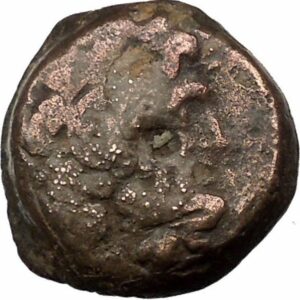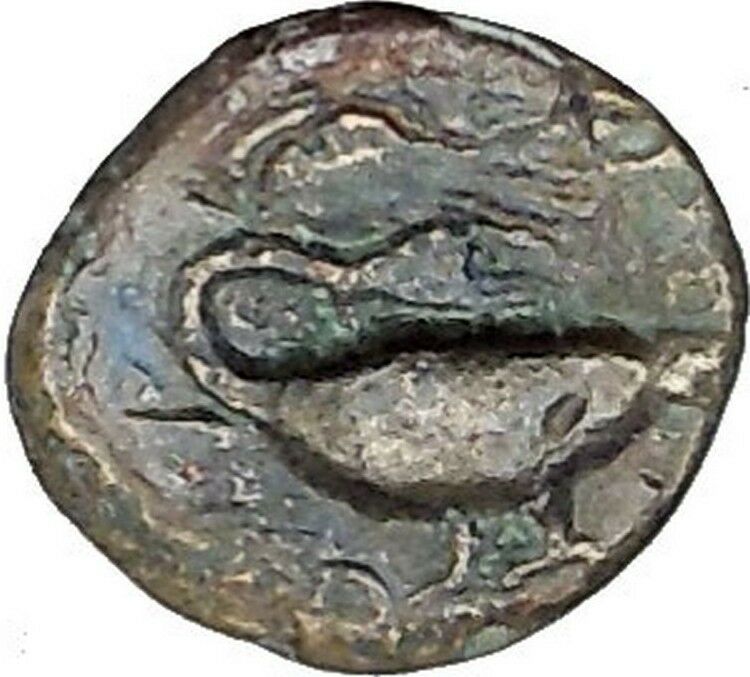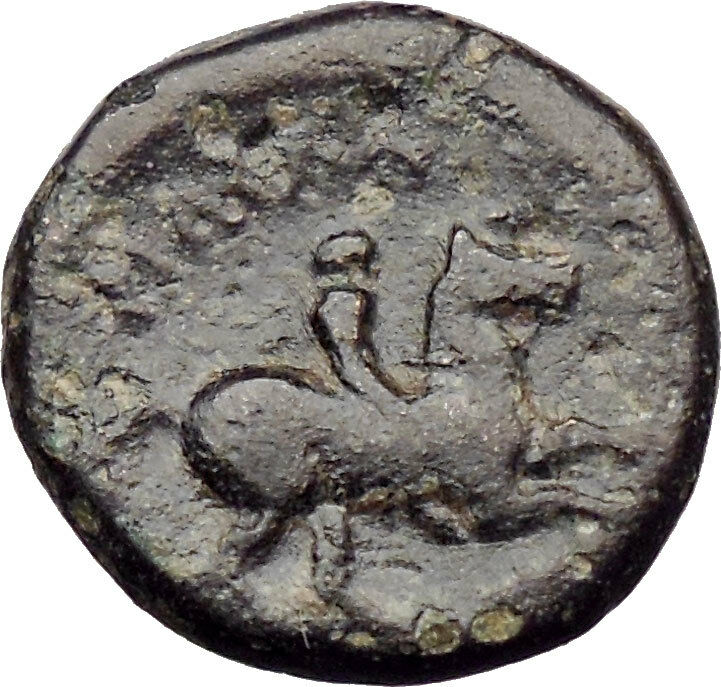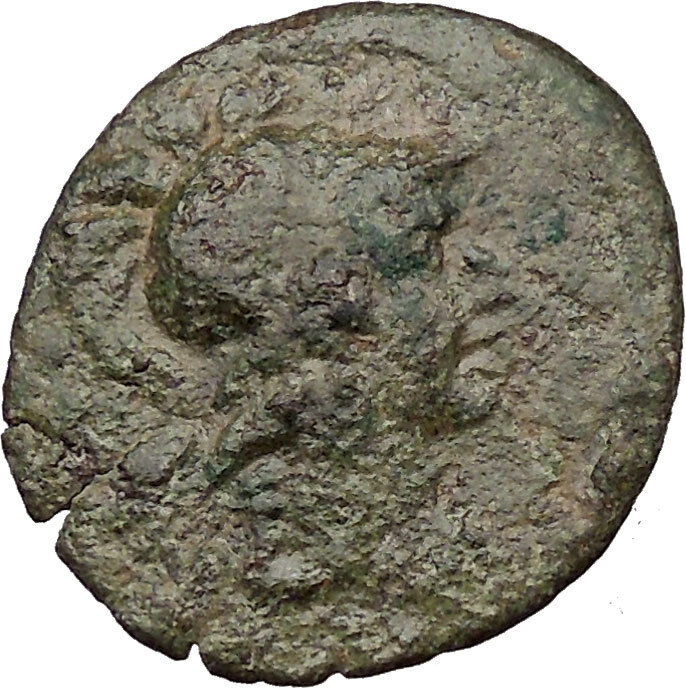|
Greek city of Lampsakos in Mysia
Bronze 9mm (1.33 grams) Struck circa 400-300 B.C.
Reference: Possibly Unpublished Type
Head of Gorgoneion facing.
ΛΑΜ, Thyrsos.
You are bidding on the exact item pictured,
provided with a Certificate of Authenticity and Lifetime Guarantee of
Authenticity.
In Ancient Greece
, the Gorgoneion (Greek:
Γοργόνειον) was originally a horror-creating
apotropaic
pendant
showing the
Gorgon‘s head. It was assimilated by the
Olympian deities
Zeus
and Athena:
both are said to have worn it as a protective
pendant.
It was assumed, among other godlike attributes, as a royal
aegis,
by rulers of the Hellenistic age, as shown, for instance, on the
Alexander Mosaic and the
Gonzaga Cameo.

Homer
refers to the Gorgon on four occasions, each time alluding to the head alone, as
if the creature had no body.
Jane Ellen Harrison
notes that “Medusa is a
head and nothing more…a mask
with a body later appended”. Up to the 5th
century BC, the head was depicted as particularly ugly, with a protruding
tongue,
boar
tusks, puffy cheeks, her eyeballs staring fixedly on the viewer and
the snakes twisting all around her.
The direct frontal stare, “seemingly looking out from its own iconographical
context and directly challenging the viewer”, was highly unusual in ancient
Greek art. In some instances a beard (probably standing for streaks of blood)
was appended to her chin, making her appear as an
orgiastic deity
akin to
Dionysus.
Gorgoneia that decorate the shields of warriors on mid-5th century Greek
vases are considerably less grotesque and menacing. By that time, the Gorgon had
lost her tusks and the snakes were rather stylized. The
Hellenistic
marble known as the
Medusa Rondanini illustrates the Gorgon’s eventual transformation
into a beautiful woman.

_-_Mailice_(1899).jpg) A A
thyrsus or thyrsos was a wand or staff of giant fennel (Ferula
communis) covered with
ivy
vines and leaves, sometimes wound with
taeniae
and always topped with a
pine
cone
.
Symbolism
The thyrsus, associated with
Dionysus
(or Bacchus) and his followers, the
Satyrs
and
Maenads
, is a symbol of
prosperity
,
fertility
,
hedonism
, and pleasure/enjoyment in general. It
has been suggested that this was specifically a fertility
phallus
, with the fennel representing the shaft
of the penis and the pine cone representing the “seed” issuing forth. The
thyrsus was tossed in the Bacchic dance:
Pentheus: The thyrsus— in my right hand shall I hold it?
-
- Or thus am I more like a Bacchanal?
Dionysus: In thy right hand, and with thy right foot raise it”.
Sometimes the thyrsus was displayed in conjunction with a
kantharos
wine cup, another symbol of Dionysus,
forming a male-and-female combination like that of the royal scepter and orb.
Use
In
Greek religion
, the staff was carried by the
votaries
of Dionysus.
Euripides
wrote that
honey
dripped from the thyrsos staves that the
Bacchic maenads
carried. The thyrsus was a sacred
instrument at religious
rituals
and
fêtes.
The fabulous history of Bacchus relates that he converted the thyrsi carried
by himself and his followers into dangerous weapons, by concealing an iron point
in the head of leaves. Hence his thyrsus is called “a spear enveloped in
vine-leaves”, and its point was thought to incite to madness.
Literature
In the Iliad
,
Diomedes
, one of the leading warriors of the
Achaeans
, mentions the thyrsus while speaking
to
Glaucus
, one of the
Lycian
commanders in the
Trojan army, about
Lycurgus
, the king of
Scyros
:
He it was that/drove the nursing women who were in charge/of frenzied
Bacchus through the land of Nysa,/and they flung their thyrsi on the
ground as/murderous Lycurgus beat them with his ox-/goad. (Iliad,
Book VI.132-37)
The thyrsus is explicitly attributed to Dionysus in
Euripides
‘s play
The Bacchae
as part of the costume of the
Dionysian cult.
…To raise my Bacchic shout, and clothe all who respond/ In fawnskin
habits, and put my thyrsus in their hands–/ The weapon wreathed with
ivy-shoots…” Euripides also writes, “There’s a brute wildness in the
fennel-wands—Reverence it well.” (The Bacchae and Other Plays, trans.
by Philip Vellacott, Penguin, 1954.)
Plato
writes in
Phaedo
:
I conceive that the founders of the mysteries had a real meaning and were
not mere triflers when they intimated in a figure long ago that he who
passes unsanctified and uninitiated into the world below will live in a
slough, but that he who arrives there after initiation and purification will
dwell with the gods. For “many,” as they say in the mysteries, “are the
thyrsus bearers, but few are the mystics,”–meaning, as I interpret the
words, the true philosophers.
In Part II of
Johann Wolfgang von Goethe
‘s
Faust
,
Mephistopheles
tries to catch a
Lamia
, only to find out that she is an
illusion:
Well, then, a tall one I will catch…/And now a thyrsus-pole I
snatch!/Only a pine-cone as its head. (7775-7777)
Robert Browning
mentions the thyrsus in passing
in The Bishop Orders His Tomb at St Praxed’s Church, as the dying bishop
confuses Christian piety with classical extravagance:
The bas-relief in bronze ye promised me,/Those
Pans
and
nymphs
ye wot of, and perchance/Some
tripod
, thrysus, with a vase or so,
(56-58)
Lampsacus (Greek:
Λάμψακος, Lampsakos, modern:Lapseki)
was an ancient Greek
city strategically located on the eastern side of the
Hellespont
in the northern Troad
.
An inhabitant of Lampsacus was called a Lampsacene. The name has been
transmitted in the nearby modern town of
Lapseki
.
//
History
Originally known as Pityusa or Pityussa
(Greek:
Πιτυουσα, Pituousa, or Πιτυουσσα,
Pituoussa), it was colonized from
Phocaea
and
Miletus
.
During the
6th
and 5th century BC
, Lampsacus was successively dominated by
Lydia
,
Persia
, Athens
,
and Sparta
;
Artaxerxes I
assigned it to
Themistocles
with the expectation that the city supply the Persian king with
its famous wine
.
Lampsacus joined the
Delian League
after the
battle of Mycale
, and paid a tribute of twelve
talents
, a testimony to its wealth, and it had a
gold coinage in the
4th
century BC
, an activity only available to the more prosperous cities.
A revolt against the Athenians in
411 BC
was put
down by force. In 196 BC
, the
Romans
defended the town against
Antiochus the Great
, and it became an ally of Rome;
Cicero
(2
Verr. i. 24. 63) and
Strabo
(13. 1.
15) attest its continuing prosperity under Roman rule. Lampsacus was also
notable for its worship of
Priapus
, who
was said to have been born there.
Lampsacus produced a series of notable philosophers.
Metrodorus of Lampsacus (the elder)
(5th century BC) was a philosopher from
the school of
Anaxagoras
.
Strato of Lampsacus
(c. 335-c. 269 BC) was a Peripatetic philosopher and the
third director of Aristotle’s
Lyceum
at
Athens.
Euaeon of Lampsacus
was one of
Plato
‘s students.
A group of Lampsacenes were in the circle of
Epicurus
;
they included
Polyaenus of Lampsacus
(c. 340 – 278 BC) a mathematician, the philosophers
Idomeneus of Lampsacus
,
Colotes
the
satirist and
Leonteus of Lampsacus
;
Batis of Lampsacus
the wife of Idomeneus, was the sister of
Metrodorus of Lampsacus (the younger)
, whose elder brother, also a friend of
Epicurus, was
Timocrates of Lampsacus
.
Christian
history
According to legend,
St Tryphon
was buried at Lampsacus after his martyrdom at
Nicaea
in 250 AD
.
The first known bishop
in Lampsacus was
Parthenius
, under
Constantine I
. In 364, the
see
was occupied by Marcian
and in the same year a council of bishops was held at Lampsacus.
Marcian, was summoned to the
First Council of Constantinople
of
Constantinople
in 381, but refused to retract his adherence of the
Macedonian
Christian
sect. Other known
Bishops of Lampsacus were
Daniel
, who assisted at the
Council of Chalcedon
(451);
Harmonius
(458); Constantine (680), who attended the
Third Council of Constantinople
; John (787), at Nicaea;
St. Euschemon
, a correspondent of
St. Theodore the Studite
, and a confessor of the Faith for the veneration of
images, under
Theophilus
.
The See of Lampsacus is mentioned in the “Notitiae
Episcopatuum” until about the twelfth or thirteenth century.
Modern
settlement
The nearby settlement of
Lapseki
has
inherited the name; its population is now in the region of 11,000.
|







_-_Mailice_(1899).jpg) A
A


